UPDATE: About 2 weeks after writing this article, Camp 30 was declared a National Historic Site of Canada.
Click to view recent aerial footage of the site.
Wikipedia says;
The Bowmanville POW camp also known as Camp 30 was a Canadian-run POW camp for German soldiers during World War II located in the community of Bowmanville, Ontario in Clarington, Ontario, Canada. In September 2013, the camp was designated a National Historic Site of Canada.
Camp 30, a former Nazi POW Camp containing 18 buildings on 40 hectares of land, sits on the outskirts of small town Bowmanville, Ontario.
CAMP 30: A VARIED HISTORY
Not only is this supposed to be the last Nazi POW Camp left standing (though it is indeed ‘crippled’), it was the first of its kind, and was the only one used by Allies to house high-ranking Nazi officers captured during World War II.
The site was chosen in part for its proximity to Camp X.
Originally developed as a boys reform school in 1925 (where, by all accounts, many atrocities were committed against the youth), the space was made to house approximately 300 young boys, and as such was cramped for the almost 1,000 full grown officers that would temporarily call Camp 30 home.
Beds were too short, the cafeteria too small (they ate in shifts), and many conveniences (some toilets, sinks, dorms, counters) were inconveniently ‘child size’.
After its POW history in the 1940’s, it was converted a few times for a variety of primarily educational uses.
St. Stephens High School (where many of my childhood friends attended classes) functioned here for many years, along with a variety of private schools including the Great Lakes College of Toronto, whose owner Thomas Ku was murdered by a student.
The buildings were abandoned in 2008, after the Islamic School that operated here closed its doors. The buildings have suffered much vandal damage since.
NAZI POW’S
German army officers from the Afrika Korps, fliers from the Luftwaffe and naval officers from the Kriegsmarine were residents at Camp 30.
From Wikipedia;
Among the German officers transferred from England to Bowmanville was Korvettenkapitän Otto Kretschmer, who was the top U-boat ace of World War II. Kretschmer assumed the duties of the senior naval officer, sharing the command with the senior Luftwaffe officer Oberstleutnant Hans Hefele and the senior army officer General Leutnant Hans von Ravenstein.
It was felt that Bowmanville was a perfect location to house the dangerous high ranking Nazis – far enough away from Europe and the bulk of the fighting, and in a rural location far enough away from the major centres of southern Ontario and Quebec.
Placing them here rendered them essentially ‘worthless’ to the war effort. That was seen as a great victory.
A COMFORTABLE LIFE
By all accounts, life at Camp 30 was comfortable. Shortly after arrival, the prisoners created gardens and had a pool and recreation centre built specifically for them.
They had lecturers come in from the University of Toronto to hold classes. They entertained themselves with puppet shows and theatrical events, and were able to make purchases with money sent from home or earned making furniture and other items on site – money that they spent on alcohol, cigarettes and items from the Eaton’s catalogue.
From thestar.com;
Run like a five-star hotel with luxuries that included an indoor swimming pool, theatre and concert stage, the camp’s true purpose was given away only by the barbed wire around it.
The occupants had one complaint, which they made to the Red Cross – the urinals were too low.
The prisoners even ran a newspaper from the Camp, and were allowed offsite to downhill ski and swim in lake Ontario.
Some of the former German Nazis recall feeling a sense of guilt for their idleness. They wanted to return to war. Others stated they were happiest at the Camp, knowing they would return safely (alive) to their homes and families when the time came.
A Luftwaffe pilot who spent time there later wrote;
“I am convinced that nowhere in the world did prisoners of war have better housing, better food, better recreation facilities, better educational opportunities, and above all, fairer treatment, than in Canada.”
There appear to be no recorded accounts of horrible living conditions, or unfair treatment here. After the war ended, many former POW’s returned. They relocated their own families and friends to the town they had grown fond of, and that had grown fond of them.
Many locals were surprised to find the Germans very polite and soft spoken. They too had been victims of WWII propaganda and were expecting to be inundated by evil monsters – not puppeteers and gardeners.
ESCAPE FROM CAMP 30
There are a few detailed accounts of escape attempts from Camp 30. Though life may have been cushy, the residents did not forget they were captive.
One attempt tells of an experience that ended with the escaping German Commander finding a local farm and asking to be taken back to Camp 30, where he said he was ‘provided a comfortable life’.
Many similar half hearted escapes of this nature (that end in asking a local to drive them back) have also been reported.
Another more elaborate escape made by prisoners Otto Kretschmer and Wolfgang Heyda was named Operation Kiebitz.
Pushed by Hitler himself to retrieve his favourite U-Boat Commanders, this attempt was known about and watched by authorities, in hopes of capturing another U-boat (& its crew) off the east coast of Canada.
The POW’s spent a long time trying to dig as far as they could (with tin cans!) in the direction of the St. Lawrence – where Hitler was to have his rescue team waiting. They ended up rising in farmland, not far from Lake Ontario.
When they surfaced, they were expected to walk, and jump trains for more than 1,400 km to the furthest reaches of the east coast to be met by said U-Boat.
Extensive tunnels were dug during this epic break out attempt, and nearly 70 years later, hidden dirt piles from the excavations were discovered in the attic of building 4, untouched for three quarters of a century.
You can read the fascinating account of this escape attempt at Wikipedia.
THE BATTLE OF BOWMANVILLE
In October of 1942, after a German ‘crank up’ in the war, 100 POW’s were asked to volunteer to be shackled for a photo that was to be sent as a threat to German authorities. None were willing to volunteer.
After asking a few (German POW) Officers if they would help, and being flatly refused, the Camp authorities thought they would try to force 100 men into shackles.
The result became known as the Battle of Bowmanville. A terrible uproar ensued – with Canadian Forces entering the grounds with nothing but baseball bats to subdue the now armed (with makeshift weaponry) German POW’s.
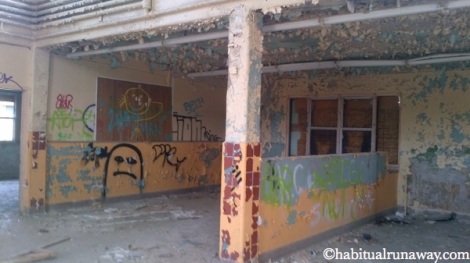
Inside the mess hall.
Canadian authorities wanted it to be a ‘fair fight’. Based in the mess hall/cafeteria, the battle lasted for days – until high powered hoses were brought in to soak the residences, pushing the POW’s to finally surrender peacefully.
I have wondered if perhaps our perceived fairness and lux accommodation may have been given out of fear, in efforts to appease. After all, they were Nazi war criminals.
At the time the world as a whole feared Germany, and Germans in general. To have such powerful, feared men right here in naive small town Canada (I can say that, I grew up in the Durham region!) would have been a truly horrifying prospect.
The ‘Battle of Bowmanville’ is a good example of what authorities here might have been worried about if they had treated the POW’s with any less ‘respect’ than they did. RETRIBUTION – and what would Bowmanville have done if an army of angry Nazi’s descended upon it to reclaim their kinfolk?
I am not sure we would have had the man power or weaponry to do much more than panic.
Of course, that is just my (slightly educated) opinion.
‘TOUR GUIDES’
On our tour we were fortunate to run into a group of ‘random teens’ (perhaps 16 years old?) who served as our tour guides.
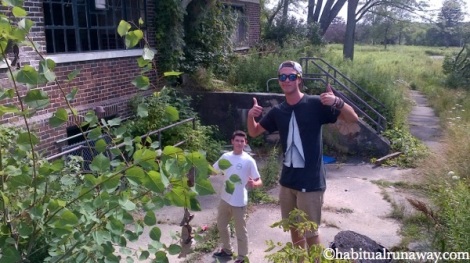
On our own, we would have looked at a few buildings, perhaps entered one or two that looked safe, and hopped back in the car – especially seeing as somehow I had managed to let both batteries die on my camera, and had only my tablet left to take photos – without a flash.
Instead we had a detailed tour of most buildings, into frightening crawl spaces, through boiler rooms, across the labyrinth of dorms, around the mess hall and up onto dangerous roof tops.

On the rooftop.
We heard stories of local folklore regarding the site, and tales of recent events that have taken place here.
We followed the expansive paved walk ways while the boys told us how (and when) the vandal damage occurred, showed us sites that old buildings used to stand and explained the recent fires (more vandalism).
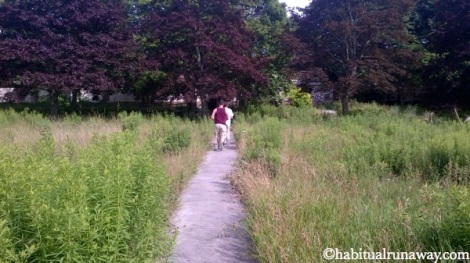
They even took additional photos for me (they had a flash for the dank, dark, horrific indoors). Hopefully I will be able to do an update to showcase their work (the one who took the bulk of the photos is currently grounded from his iphone until September – LOL!).
Our small group weren’t the only trespassers that day, we encountered other curious groups while there. Apparently this is a popular spot for such intrusions. Hopefully the curious will still come when charged a small fee for upkeep and maintenance – if the Camp is lucky enough to make it that far.
THE FUTURE OF CAMP 30
For many years, a few dedicated locals have been trying to save Camp 30 from demolition. Recently the land was purchased by a developer who was not aware of the sites history.
Initially, he publicly stated that ‘he couldn’t see the point in saving the derelict, vandalized buildings’. After receiving a copy of a book written in part by a local historian about Camp 30 and its incredible history, he changed his tune.
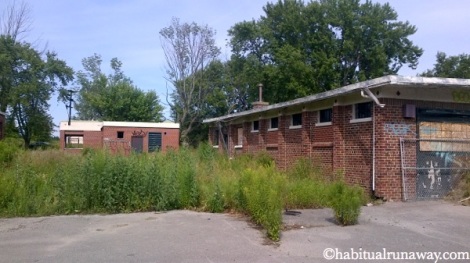
Stating ‘he had no idea’ of the historical value of the land, 10 hectares of important Camp 30 terrain (the section containing buildings) was sectioned off by the empathetic developer to be decided upon at a later date. He will build around Camp 30.
What happens now is anyones guess. The Federal Government has gifted a yearly amount to preserve and restore the site, but having been there myself, clearly it is not nearly enough.
In order for that money to be matched (which still wouldn’t be enough), every resident of the Durham region would need to face a 3% property tax increase.
Bowmanville is not a wealthy town, though it is ‘better off’ than the small surrounding towns and hamlets – it simply can’t handle such an increase to preserve world history.
Hopefully something is worked out that is not to the detriment of locals. It would be a travesty to lose this significant and rare piece of WWII history because of a ‘simple’ (but dramatic) lack of funding.
Click to view an aerial of the historic site.
Many additional photos of Camp 30 in the slideshow.
Follow this tour by heading to the ‘Crossing Canada‘ section. Enjoy many more photos at the Habitual Runaway on Facebook.
Related articles
- Operaton Kiebitz (wikipedia)
- Camp 30 Fights On (Torontoist.com)
- Historic Camp 30 Saved From Wrecking Ball (the star.com)
- Ontario’s Forgotten Landmarks Camp 30 (blogto.com)
- D Day in Bowmanville for Nazi POW Camp (the star.com)
- Camp 30 (flickr)
- Spirits of Camp 30 (Durhamregion.com)
- Bowmanville POW Camp (wikipedia)

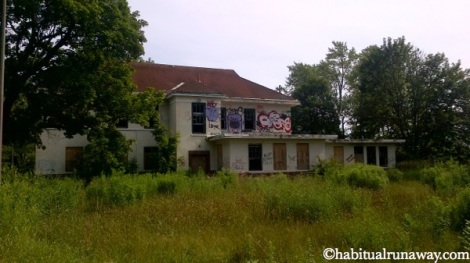
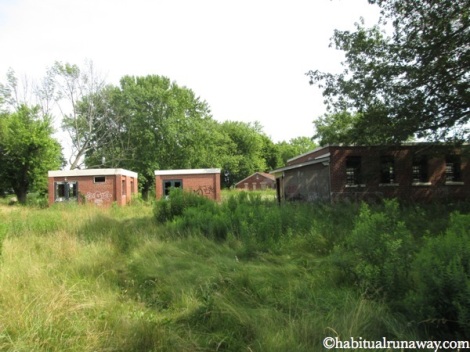
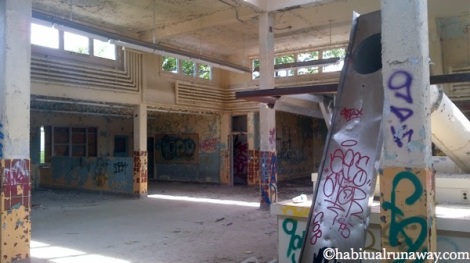
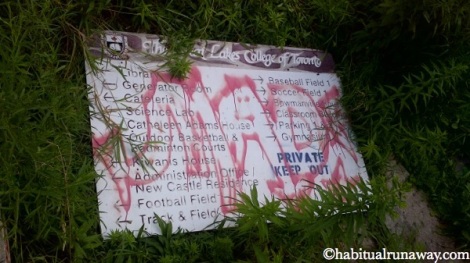
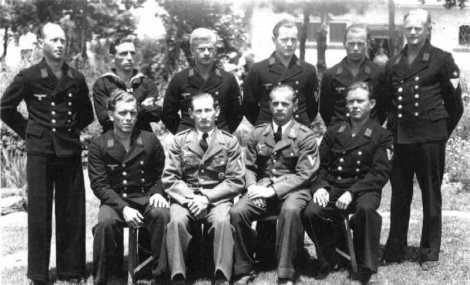

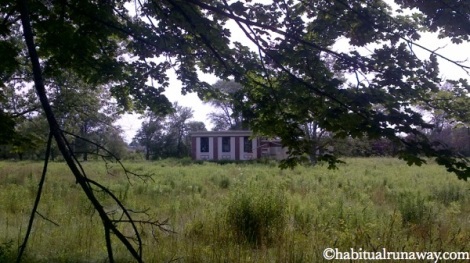
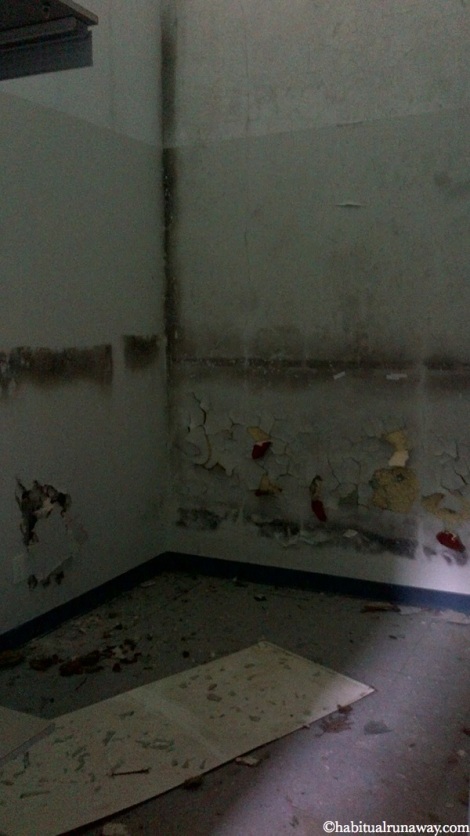


Amazing. Never knew.
LikeLike
Incredible, right?
LikeLike
i was there for 13 months. most sadistc guards possible. hi gear hanson was a sicko. i
i am now a well off , well educated man, but I learned to hate and steal in Bowmanville school for boys.
LikeLike
I am so sorry you had a horrible experience at the boys school. I actually have more than one friend who spent time there in their youth & they say the EXACT same thing as you. That it was beyond awful. That thy were abused sexually, emotionally & physically. Not all of them ‘made it through’. Some never get over the abuses they suffer as children, I am happy to hear that you managed to recreate your life even after the horror.
LikeLike
Did you know a Mr. Hall who worked there?
LikeLike
I spent 6 weeks there before being transferred to the Simcoe School for Boys in the early 60’s. I was trying to find the Simcoe facility on Google maps when I came across this article. I had no idea that it was a POW camp at the time.
LikeLike
I spent 3 months there…yes,there was girls too.Only a few of us though.Only one dorm full.The place was horrible and yes much abuse.They closed down and I was shipped to Cobourg reform school where abuse was horrendous as well.From there I was sent to Syl Apps which was much better than the other two.The amount of abuse that crown wards suffered is of which many never recover from.
LikeLike
I am sorry you (and many others) received such horrible treatment – especially in a place that should have been providing support for the people it housed. Thank you for sharing your story.
LikeLike
true i visited you there. You told me everything. As far as i recall there was still active military there in a small area. Cause i opened the wrong door. when i should have went to the barn door at the back where newcomers go they redirected me.
LikeLike
Thank you, for your followers in the Bowmanville area. The Clarington branch of the ACO meet the third Wednesday of each month usually at the Sarah Jane Centre. We are actively working to preserve the Camp 30 site, along with other historically & cultural significant locations in the Clarington area. New members are always welcome
LikeLike
Thank you for the info, I will post it additionally on my other social network sites, and link to the article.
…And thank you for being a part of the dedicated team trying to preserve this incredible site. My fingers are crossed and my breath is held!
Ana
LikeLike
Never heard of this, an amazing story. Thanks for posting!
LikeLike
I hadn’t heard until a few years ago – and I GREW UP just a few miles away…!!! Some people who live in Bowmanville don’t even know! A surreal part of history – for sure… (& thanks for reading, John – it was a loOoOong post!)
LikeLike
You bet! I hope things are going good for the family.
LikeLike
Thank you John :).
LikeLike
aids
LikeLike
Fantastic explore, Ana, thanks for sharing…. 🙂
LikeLike
& Thank you for taking a look – a LOT of words! 😉
LikeLike
Thank you for your efforts to bring attention to this site. As a member of the group of people who have worked to protect the site, I do want to clarify that Camp 30 did not house Nazis. Captured Nazis were housed in POW camps in Alberta. The site has been declared a National Historic Site now and as such is eligible for grant programs. Our country as a whole should be trying to protect this site and not leaving that protection to a small town in Ontario.
LikeLike
How interesting Martha – funny that in the many, many hours of research I did, EVERYTHING I found said we DID house Nazis at Camp 30. Even Wikipedia said that Hitler himself ordered the escape of his favourite U-Boat officials. Do you happen to have a resource link that would provide facts to the contrary? I would love to be able to go further into that.
(From Wikipedia & my grade school learning);
Nazi Germany and the Third Reich are common names for Germany during the period from 1933 to 1945, when its government was controlled by Adolf Hitler and his National Socialist German Workers’ Party, commonly known as the Nazi Party. Under Hitler’s rule, Germany was transformed into a totalitarian state where nearly all aspects of life were controlled by the state. Nazi Germany ceased to exist after the Allied Forces defeated the Wehrmacht in May 1945, thus ending World War II in Europe.
My understanding is that from 1933 to 1945, GERMANY was considered Nazi (& certainly his military was referred to as such), thanks to Hitlers Nationalist Government – a Totalitarian State.
I fully agree that our country as a whole should be responsible for what becomes of Camp 30. Being from the area myself, I think it would be nothing less than ridiculous to expect Clarington & Durham to handle that cost. Just not feasible – and it is WORLD history above everything else!
Thanks for your input :).
LikeLike
Such an informative article and it shows that history begs to be questioned. Fast paced writing supported by documented facts and photos both past and present with the addition of commentary. A most excellent coverage of Camp 30. Thank you!
LikeLike
Thank you! 😉
LikeLike
You must understand, that there was child abuse in Bowmanville.
They actually had a wing in Central House with 5 solitary confinement cells. I spent a couple of weeks there with a kid named Van Dyke who killed himself. Other namers where Horvath and Ward.
LikeLike
I am so sorry to hear about that. I am sure they are grateful that you keep their story, and their memory alive. I have big problems with the way ‘we’ treat troubled youth here in Canada. My time in the area led me to become a child youth worker – I am a strong believer in finding alternative ways to HELP ‘troubled’ youth – I was one myself. Brookside was a horrible place too. Inflicting further atrocities upon children never helps….
LikeLike
My grandfather was raped and beaten here back then. He had night sweats. Cold sweats walk up yelling top of his lungs while sound asleep!!!!!!!!!
LikeLike
The digger as we called the cells..you’re going to the “digger’…Damn the memories.
LikeLike
My fahter was a resident of this boys reform school. The stories he tells are horrific.
LikeLike
Goodness, I am sorry to hear that. I cannot imagine the horror of living through such an experience. I would think it is the kind of thing you carry around with you for your entire life. Thanks for sharing…
LikeLike
As was my grandfather he would even try and take all the sexual abuse and beatings for the young boys so they wouldn’t have to experience some of the Rath
LikeLike
My grandfather was raped over and over beaten over and over again at the age 14 we think to 16. He would be asleep cold sweats hot sweats. .. wake yup just screaming on the top of his lungs until the day he passed because of how the treated “their” boys … makes me sick!
LikeLike
I visited my brother in Bowmanville reform school around 1959 and my other brother had been there 2-3 years before that. My brother was told not to talk about it when younger family members were around. He met another person there who lived in same city as we did and they remained friends for life. I have often wondered what became of this place. Thank you for writing about it.
LikeLike
Good read. I spent four years attending these grounds when it was St. Stephen’s high school. If I remember correctly, some of the german soldiers came to visit the school during my last year there. It was some sort of anniversary. Sad to see that it has fallen to such a state of disrepair. Both good and bad memories were made there.
LikeLike
You remember correctly! My dad took care of the grounds because they were owned by the church we attended at the time. He is from Belgium and speaks German so he was helping translate as well. I used to visit those grounds a lot. It is sad the state that it has come to.
LikeLike
I also went to St. Stephen’s there from 1987-1990. The main building we used most is now burned down, such a shame. So many great memories in that building. It’s sad what people do for kicks to destroy property, especially a Historic Piece of History such as this. I really hope they restore this place not demolish it. Hope for best.
LikeLike
I lived with my family in the barracks at the Bowmanville school in 1946.
A crew of men were dismantling the watch Towers at that time
Some of the buildings were being torn down at that time ,and all nails being pulled out,straightened and saved.
The boilers were active and heat was on in Nov,46
LikeLike
Its such a sad thing to hear of all the nightmarish things that went on well being in there. I know that no words can make up for what had not only been taken from you, but what had been done in there. The pain of wakeing up in the mornings knowing what you had to endure, I truly feel for those who endured the agony. But knowing what was out there made you all exceptional parents, for you to protect your children from the past encounters that you all experienced
LikeLike
Very interesting read. It reminds me of my grandpa who was a guard in a POW prison towards the end of WWII. He told me they were so outnumbered by the prisoners & had only a minimal supply of weapons (rifles & bullets) that they befriended the prisoners because it made more sense then trying to subdue them. It was to the point that they would let some of the POW’s use their rifles to go hunt in order to feed the whole camp (prisoners & guards)
LikeLike
Nice to see a write up about this place! There is one book in particular out there that is instrumental in learning the history of the place during the POW time. It is called Word of Honour: Camp 30. I believe the writer also wrote a book about Camp X (sadly demolished). The church I was attending as a kid owned the grounds for a while, before it was sold to the Chinese school, and while the Catholic board was renting the grounds for St Stephens. My dad was the caretaker/maintenance man for the whole place. One of my childhood friends used to live there, in the building across the lawn from the cafeteria, and we used to run around and play all over the grounds. It was actually a really nice place back then. My dad has photos of the POW reunion (what year I cannot recall). It would be a nice piece of history to keep if restoration could be made to it.
LikeLike
NatP, Thank you for mentioning the Chinese school. I visited this place in 2002, when it was a Chinese school, and it looked dated but very beautiful then. I didn’t know the place’s history then. I thought it was a great place for a reform school for the boys. How did all of this vandalism happen? Why did the Chinese school and the Catholic school stop running. I met a man at the grounds when I visited who showed me the giant salmons at a creek at the “back” of the complex. Any info would be highly appreciated. Best, Jean
LikeLike
Went to high school there for a year or 2… was always so eerie there.
LikeLike
I wrote a book in frenche about Operation Kiebitz and the Bowmanville escape in 1992, resident of Caraquet Nb, the recapture of Wolfgang Heyda , 1943 was at the Lighthouse at Pointe de Maisonnette, acroos the caraquet Bay. I was in contact with the U-Boot first watch officer, Von Bartenwffer died 10 years ago, he gave me an accont from the german version. the RCN was aware of this secret operation…
Jean-Guy
LikeLike
http://ontarioabandonedplaces.com/upload/wiki.asp?entry=613
Some photos and history
LikeLike
I spent 6 weeks there before being transferred to the Simcoe School for Boys in the early 60’s. I was trying to find the Simcoe facility on Google maps when I came across this article. I had no idea that it was a POW camp at the time.
LikeLike
I grew up very near there…biked past it every weekend on my way to piano lessons. Was told as a young child that if we heard the alarm, to take the laundry inside (so clothes couldn’t be taken), and go inside and lock the doors. I believe my grandfather was a guard there when it was a POW camp, but I should verify that with my mother.
LikeLike
My grandfather used to tell of escorting Nazi Officers by train from the Brooklyn Naval Yards to a POW camp in Ontario. Now I know where. Thanks for this post.
LikeLike
Oh I wish I could hear some first hand tales – what an honour!
LikeLike